ECOLOGICAL FARMING RESOURCES
From practical videos to scientific studies, we’ve gathered a variety of resources to help farmers enhance ecological practices on their farm. Grow food while increasing biodiversity, reducing GHG emissions, sequestering carbon in the soil and conserving natural resources like water and topsoil.
Compost:
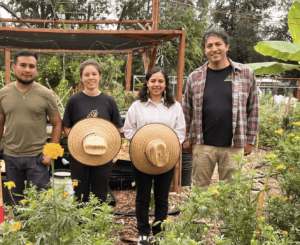
CRECE Urban Farm Collective, Spreadwing Farm, and CAFF’s Dave Runsten podcast episode
In this episode we delve into all things on-farm composting, from its production to its use and relevant agricultural policies. We hear from Abel Ruiz at CRECE Farming Collective in

Spreadwing Farm: Compost on a Diversified Small Farm
Spreadwing Farm, located in the Capay Valley, utilizes compost in their vegetable crops to improve the quality of the soil and provide plant available nutrients. Learn more about the benefits,

On Farm Composting Video
This video explores on-farm composting, including a brief overview of California’s new best management practices mandate for on-farm composting as well as the food safety and organic requirements. Hear from

State Water Resources Control Board Limits Regulation of On-Farm Composting
(Updated 4/15/20) The State Water Resources Control Board’s Compost General Order that passed in 2015 presented a regulatory obstacle for on-farm composting, despite the state’s efforts to reduce waste and

California Okays On-Farm Compost, Key to Sustainable Agriculture
Sacramento, CA – After more than five years of negotiations, the State Water Resources Control Board issued a historic decision to allow for much-needed composting on California farms. “Farmers can

Technical Assistance for the Healthy Soils Program
TECHNICAL ASSISTANCE FOR THE HEALTHY SOILS PROGRAM Are you interested in implementing cover crops, compost, hedgerows and other Healthy Soils practices on you farm? The California Department of Food and

Compost: What Does the Research Say?
Composting plant materials and manure offers a practical way to recycle crop residue and animal waste. The process of decomposition of these materials is sped up to provide a

How to Add Compost on Your Small Farm
Compost provides nutrients to plants, improves soil structure, increases water holding capacity, and suppresses root diseases by supporting benefi cial microorganisms in the soil. It also helps improve porosity and

Building Soils for Better Crops
Building Soils for Better Crops is a one-of-a-kind, practical guide to ecological soil management, now expanded and in full color. It provides step-by-step information on soil-improving practices as well as in-depth

Compost Use in Agriculture: Organic Materials Management
Use of composted manures and plant materials in farming has a history almost as long as farming itself. California farmers enjoy access to high-quality compost and mulch products from a variety of

Compost Science Webinar
Originally aired March 8, 2017 | Composting is both an art and a science. For some, composting is a passion and an emotional experience, but often when we start thinking

Agricultural Composting & Water Quality
Composting, a controlled process for stabilization of organic matter, can turn waste into a valuable soil amendment. Creating compost from waste materials provides an opportunity to return nutrients and organic
Cover Crops
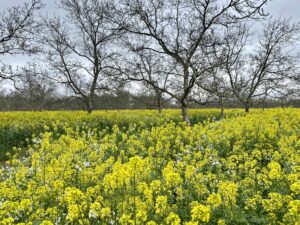
Cover Crops in Orchards case study
Do you want to learn more about the ins and outs of planting and managing cover crops from growers with cover crop experience? Check out our Cover Crops in Orchards

Getting the Biologically Integrated Orchard Systems (BIOS) demonstration project off the ground!
The BIOS project is underway! CAFF’s Ecological Farming team has been busy the past several weeks setting up the Biologically Integrated Orchards Systems (BIOS) project at six demonstration sites located

Biologically Integrated Orchard Systems (BIOS) for Almonds guide
The Biologically Integrated Orchard Systems (BIOS) project was a collaboration between CAFF, farmers, pest control and crop advisors, and the UC Cooperative Extension in the 1990s and early 2000s. BIOS

CAFF’s Cover Crop Decision Guides
We’re excited to share two new resources for growers: our Cover Crop Decision Guide for Perennial Systems and Cover Crop Decision Guide for Annual Systems created in collaboration with

Covercrops for California Agriculture
For many agricultural soils, cover crops offer the only means of supplying the organic matter needed to keep the soil in a high state of productivity. Learn how to select

Technical Assistance for the Healthy Soils Program
TECHNICAL ASSISTANCE FOR THE HEALTHY SOILS PROGRAM Are you interested in implementing cover crops, compost, hedgerows and other Healthy Soils practices on you farm? The California Department of Food and

Cover Crops for Walnut Orchards
Walnut orchards present unique challenges to the successful use of cover crops. These include short time between harvest and leaf fall for establishing the cover crop…

Managing Cover Crops Profitably
SARE’s publication is available free for download and is a comprehensive and practical resource with recommended species by U.S. region, a section on management in conservation tillage systems, soil fertility,

Grazing Cover Crops
How to manage livestock with adaptive grazing on cover cropped land, from the Wallace Center. The use of cover crops in row crop farming is becoming increasingly popular. According to

Cover Cropping in Vineyards
The use of cover crops can yield substantial benefits or be the source of unforeseen problems or drawbacks. The choice of which species to sow, as well as the decision

Building Soils for Better Crops
Building Soils for Better Crops is a one-of-a-kind, practical guide to ecological soil management, now expanded and in full color. It provides step-by-step information on soil-improving practices as well as in-depth

Cover Crop Economics
When it comes to making the big decisions about managing a farm, whether it’s to grow a new crop, buy an expensive piece of equipment or upgrade infrastructure, farmers are business people

Cover Crops Database
Cover crops can be broadly defined as any non-cash crop grown in addition to the primary cash crop. They have the potential to increase soil organic matter (SOM), protect the
Bio-Intensive No-Till
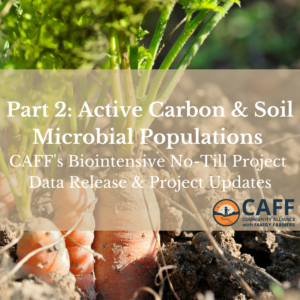
No-Till News: An Update on CAFF’s Biointensive No-Till Project
CAFF’s Biointensive No-Till Project is an on-farm demonstration project partnering with small, diversified vegetable farms in Northern California who are committed to minimizing tillage and interested in learning about how

No-Till News: An Update on CAFF’s Biointensive No-Till Project
Since 2017, CAFF’s Ecological Farming team has been conducting an on-farm demonstration project in collaboration with California no-till farmers to better understand small-scale biointensive no-till farming’s effect on soil health.

CAFF’S On-Farm Occultation Research Report
Research and recommendations on occultation Building on our work in biointensive no-till systems, CAFF’s Climate Smart Farming team launched a research trial on California vegetable farms on a related practice

Technical Assistance for the Healthy Soils Program
TECHNICAL ASSISTANCE FOR THE HEALTHY SOILS PROGRAM Are you interested in implementing cover crops, compost, hedgerows and other Healthy Soils practices on you farm? The California Department of Food and

Building Soils for Better Crops
Building Soils for Better Crops is a one-of-a-kind, practical guide to ecological soil management, now expanded and in full color. It provides step-by-step information on soil-improving practices as well as in-depth
Integrated Crop & Livestock Systems
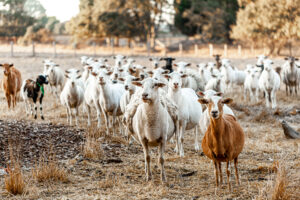
Farmers Beet Podcast on Integrated Crop Livestock Systems with Eatwell Farm – Dixon and Pasture42 – Guinda
In this episode, we learn about integrated crop livestock management from two Northern California Farms. First, we hear from Lorraine Walker of Eatwell Farm in Dixon, CA, where they incorporate

5 Key Wildfire Resilience Practices
It’s not always obvious that some of the ecological farming practices used frequently by farmers, also provide wildfire protection and recovery benefits. Check out the infographic below which was developed
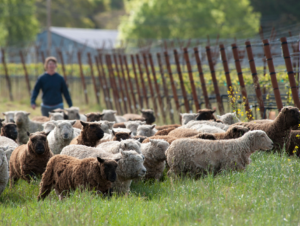
Grazing Sheep in Vineyards case study with Pennyroyal Farm
As part of our work in Ecological Farming and more broadly as an organization, CAFF aims to share stories of California growers and ranchers and the incredible work they do

Integrating Sheep into Walnuts: a case study on Sierra Orchards
Want to find out more about the benefits and tradeoffs of integrating sheep into orchard systems? Check out our newest case study on Sierra Orchards of Winters, CA. Sean McNamara

Integrating Livestock & Crops: Improving Soil, Solving Problems, Increasing Income
An introductory bulletin covering benefits and considerations of livestock-crop integration, including further reading resources. From the National Center for Appropriate Technology (NCAT).

Integrating Livestock into a Cropping System for Sustainability & Soil Health
USDA NRCS East National Technology Support Center View this webinar to learn how the Small Angus Ranch in Burleigh County, North Dakota, is working toward the goals stated in the

Grazing Cover Crops
How to manage livestock with adaptive grazing on cover cropped land, from the Wallace Center. The use of cover crops in row crop farming is becoming increasingly popular. According to

Wildfire & Rangeland Management: Mediating Impacts to Conservation & Ranching
A series of presentations from California ranchers, technical advisors, and researchers on wildfire risk management in rangelands. From the California Rangeland Conservation Coalition.

Integrating Livestock and Crops
Traditional farms relied on livestock to maintain soil fertility and to use plant material that would otherwise have been wasted. Modern agriculture has tended to favor specialization, leading to large

Sheep Grazing to Manage Crop Residues, Insects and Weeds
Recommendations for timing of grazing, stocking rates, animal selection, and more for purposes including weed and crop residue management in Northern Plains Grain and Alfalfa Systems.
Hedgerows & Farmscaping

Hedgerows & Farmscaping for California Agriculture guide now available for download
CAFF’s in-depth manual will help you choose and care for regionally appropriate plants that attract beneficial insects and prevent erosion. This publication is an updated revision of the original, 2004,

Technical Assistance for the Healthy Soils Program
TECHNICAL ASSISTANCE FOR THE HEALTHY SOILS PROGRAM Are you interested in implementing cover crops, compost, hedgerows and other Healthy Soils practices on you farm? The California Department of Food and

Biodiversity: What it is, and How to Increase it on your Farm
This brochure was developed by the Wild Farm Alliance and CAFF defines Biodiversity as it relates to agriculture, and describes specific practices that farmers can implement to conserve biodiversity on

Farming with Food Safety and Conservation
Food-borne illness linked to pathogens in meat, processed food, and produce has led to increased attention to food safety issues at all points along the supply chain, including the farm.

Biodiversidad: ¿Que es? Cómo Incrementarla En Su Rancho
Biodiversidad (o diversidad biológica) es la variedad de vida. La biodiversidad comprende toda forma de vida, desde bacterias y hongos hasta pastos, helechos, insectos, y mamíferos. Más que eso, cubre

Hedgerows: Benefits to Farmers, Benefits to wildlife
A short guide to hedgerow design, installation, and maintenance. Prepared by the Resource Conservation District of Santa Cruz County and CAFF.

Hedgerows: Enhancing Agroecological Services
Hedgerows are linear assemblages of trees, shrubs, herbs and grasses densely planted along the borders of fields. Hedgerows provide multiple services including windbreak, erosion control, restoration of biodiversity, pollination, and

Extending Hedgerow Systems in California Agriculture
When modern agriculture replaces natural habitat with crops, risks rise for soil erosion and runoff that can reduce water quality and its attendant impacts. Likewise, dust from farming activities can

Hedgerow Farms Case Study
John Anderson’s love of wildlife and concern about disappearing wildlife habitats is what drove him to become a farmer. He and his wife Marsha bought their Yolo County farm in
Other Ecological Farming Resources

Evaluating your Irrigation System with the Mobile Irrigation Lab (video + Q&A)
Looking to learn how to maintain your micro irrigation system for better irrigation efficiency? Learn more with Kevin Greer, Manager of the Tehama County RCD’s Mobile Irrigation Lab. Read below

Biologically Integrated Orchard Systems (BIOS) for Almonds guide
The Biologically Integrated Orchard Systems (BIOS) project was a collaboration between CAFF, farmers, pest control and crop advisors, and the UC Cooperative Extension in the 1990s and early 2000s. BIOS

New Funding: Soil Health Management in Orchards
Financial & technical assistance available through participating in On-Farm Conservation Innovation Trials with the East Stanislaus Resource Conservation District! View below or download the application here.

